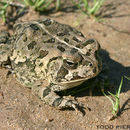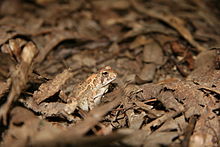en
names in breadcrumbs


There are no other pertinent comments.
Protection of the breeding sites for Anaxyrus fowleri is very important to their existence. Off-road vehicles that are commonly used in beach and dune habitats are damaging to this species. Also, the use of agricultural chemicals share in the blame for the decline of Anaxyrus fowleri in some areas. They are considered a species at risk in Ontario.
US Federal List: no special status
CITES: no special status
State of Michigan List: no special status
IUCN Red List of Threatened Species: least concern
Development - Life Cycle: metamorphosis
Anaxyrus fowleri is useful to have in gardens because it eats many insects and other small invertebrates.
The adults eat insects and other small terrestrial invertebrates, but shy away from earthworms, unlike their close relative, Bufo americanus. As a tadpole, Anaxyrus fowleri use their mouth, which is rimmed with tooth-like structures, to scrape attached algae from rocks and plants. The tadpoles are also known to feed on bacteria and other organic material from the water.(Harding, 1997)
Anaxyrus fowleri is a toad commonly found in areas of the Atlantic Coastal Plain. Its range consists of New Hampshire to eastern Texas, eastern Arkansas, Missouri, and southeastern Iowa, eastward into Michigan through Ohio, and West Virginia to the Atlantic coast. Extensions include up the Hudson, Delaware, Susquehanna, Ohio, and other rivers and into southern Ontario, along Lake Erie.
Biogeographic Regions: nearctic (Native )
Anaxyrus fowleri prefers to live in open woodlands, sand prairies, meadows, and beaches. They like to burrow into the ground during hot, dry periods and in the wintertime.(Harding 1992 and Harding 1997)
Terrestrial Biomes: savanna or grassland ; forest
Anaxyrus fowleri comes from the order Anura which are animals noted for having a toothless jaw and enlarged parotoid glands behind the eyes. They are usually brown, gray, or olive green in color and have black edged dark spots on its back, with a light middorsal stripe. In each of the dark spots there are found to be three or more warts. The belly is usually whitish and almost completely unspotted. Males are often found to be darker in color while females are found to be lighter. Anaxyrus fowleri is noted for having a single dark spot on its otherwise spotless belly. Its body measures between 5 to 9.5 centimeters in length. Anaxyrus fowleri tadpoles have a short oval body and a long tail with an upper and lower fin. Their size is 1 to 1.4 centimeters long.(Wright, 1949 and Collins, 1991)
Other Physical Features: ectothermic ; bilateral symmetry
Anaxyrus fowleri is known to reproduce in warmer seasons of the year, usually between the months of May and June. Breeding sites are located in shallow waters that are very open, including farm ponds, lake edges, marshes, and woodland ponds. Breeding habits of Anaxyrus fowleri are very similar to Bufo americanus. The male will migrate to the breeding sites where he will begin calling his mate in intervals that can last up to thirty seconds. The call often attracts both male and females which will cause mistaken identities in the breeding process. This mistake occurs when one male tries to mate with another male. Fortunately, the first male will realize the mistake right away because the other male will let out a chirping release call that informs the first one of his mistake. When the male finally meets his mate, the male will try to clasp the female from behind. From this position the male can fertilize up to 7,000-10,000 eggs. Fertilization is external. The eggs are known to hatch in two to seven days. The tadpoles will begin to undergo the change into tiny toads thirty to forty days later. In one growing season, Anaxyrus fowleri may grow to sexual maturity, but slower growing individuals may take up to three years before they reach their sexual peak.(Harding, 1992 and Harding, 1997)
Key Reproductive Features: gonochoric/gonochoristic/dioecious (sexes separate)
Fowler's toad[3] (Anaxyrus fowleri) is a species of toad in the family Bufonidae. The species is native to North America, where it occurs in much of the eastern United States and parts of adjacent Canada.[1][2] It was previously considered a subspecies of Woodhouse's toad (Anaxyrus woodhousii, formerly Bufo woodhousii).[2][4]
The specific name, fowleri, is in honor of naturalist Samuel Page Fowler (1800–1888) from Massachusetts, who was a founder of the Essex County Natural History Society, which later became the Essex Institute.[5]
Fowler's toad is usually brown, grey, olive green and rust red in color with darkened warty spots. If the toad has a pale stripe on its back, it is an adult. The belly is usually uniformly whitish except for one dark spot. The male may be darker in overall color than the female.
The adult toad is typically 5 to 9.5 cm (2.0 to 3.7 in) in head-body length. The tadpole is oval with a long tail and upper and lower fins, and is 1 to 1.4 cm (0.39 to 0.55 in) long.
Their native geographic range is eastern North America. Their range extends throughout most of the southeastern and eastern United States and parts of southeastern Canada. They reside in areas near temporary or permanent wetlands as well as forested areas.
Fowler's toad reproduces in warmer seasons of the year, especially in May and June. It breeds in open, shallow waters such as ponds, lakeshores, and marshes. The male produces a call which attracts not only females, but also other males. The calling male may attempt to mate with one of the other males, which will then produce a chirping "release call", informing him of his mistake. It has been found that male Fowler's toads mating calls are affected by the body size and temperature of the caller. Females are often able to discriminate between variations in these calls and select the largest available males.[6] Males are able to alter their calls to make them seem more attractive to females through thermoregulation. When a male finds a female, the pair will initiate amplexus and up to 7,000 to 10,000 eggs are fertilized. They hatch in 2 to 7 days. Based on observations, Fowler's toads breed repeatedly through the spring.[7] As many as 10 different age classes, separated by several days, have been observed over the course of a breeding season in one small pond. A new tadpole may reach sexual maturity in one season, but the process may take up to three years.
Fowler's toad regularly hybridizes with two of its close relatives: the American toad and the Woodhouse's toad. The Woodhouse's toad subspecies Anaxyrus woodhousii velatus, or the East Texas toad, is possibly a hybrid of the Woodhouse's toad and the Fowler's toad.[8]
Predators of Fowler's toad include snakes, birds, and small mammals. It uses defensive coloration to blend into its surroundings. It also secretes a noxious compound from the warts on its back. The secretion, containing toxic bufadienolides, is distasteful to predators and can be lethal to small mammals.[9] The toad is also known to play dead.
Fowler's toad lives in open woodlands, sand prairies, meadows, and beaches. It burrows into the ground during hot, dry periods and during the winter. They are often found hiding under broad leaved plants, amidst clumps of grass, and inside or under logs.[10] Their springtime emergence is associated with increased temperature, relatively little rainfall or wind, and a gibbous moon. [11]
The adult Fowler's toad eats insects and other small terrestrial invertebrates, but avoids earthworms, unlike its close relative, the American toad (Anaxyrus americanus). This toad also has been shown to eat velvet ants, which is an ant that gives a very painful sting to humans, but does nothing to the toad.[12] The tadpole scrapes algae and bacterial mats from rocks and plants using the tooth-like structures in its mouth.
An important conservation measure for Fowler's toad is the protection of its breeding sites. Off-road vehicles commonly used in beach and dune habitats are damaging to this species. Agricultural chemicals have caused declines in some areas. These factors along with specific habitat requirements and excessive human activity within these habitats produces permanent, local extinctions.[13] It is considered a species at risk in Ontario,[4] a species of special concern in the U.S. state of New Jersey,[14] and a regionally threatened or endangered species in the states of New Hampshire[15] and Vermont.[16]
 Fowler's toad in leaf litter
Fowler's toad in leaf litter Fowler's toad (Anaxyrus fowleri) is a species of toad in the family Bufonidae. The species is native to North America, where it occurs in much of the eastern United States and parts of adjacent Canada. It was previously considered a subspecies of Woodhouse's toad (Anaxyrus woodhousii, formerly Bufo woodhousii).